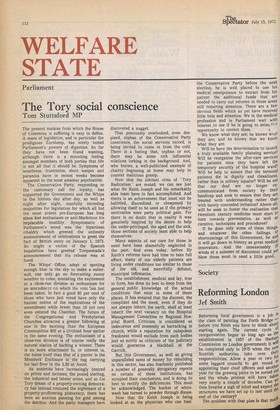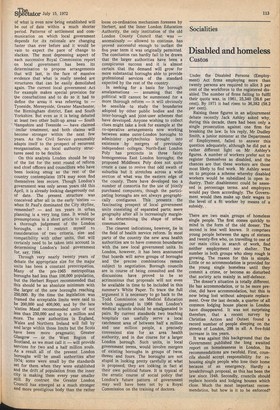Society
Reforming London
Jef Smith
Reforming local government is a job in the class of painting the Forth Bridge before you finish you have to think about starting again. The current cycle of reorganisation began as long ago as the establishment in 1957 of the Herbe.r',, Commission on London government; it Wit' be completed only in 1975 when the peW Scottish authorities take over their responsibilities. Allow a year or two f°1. some laggard councils to get round te appointing their chief officers and another, year for the growing pains to be sorted ollt and the whole process will have takes very nearly a couple of decades. Can We then breathe a sigh of relief and expect the structures we have set up to last until the end of the century?
The problem with that plan is that mucti of what is even now being established will be out of date within a much shorter period. Patterns of settlement and communication on which local government depends for as rationale are changing faster than ever before and it would be vain to expect the pace of change to slacken. The most depressing aspect of each successive Royal Commission report on local government has been its determination to propose arrangements that will last, in the face of massive evidence that what is really needed are structures that can be easily demolished again. The current local government Act for example makes special provision for the conurbations and to do so it had to define the areas it was referring to — Tyneside, Merseyside, Greater Manchester, the Birmingham district, East and South Yorkshire. But even as it is being debated at least two other built-up areas — South T-lampshire and Teesside — have claimed ,imilar treatment, and both claims will become stronger within the next few years. As the Civil Service presumably adapts itself to the prospect of recurrent reorganisation, so local authority structures need to be flexible.
On this analysis London should be top of the list for the next round of reform and chief officers and councillors who have been looking smug as the rest of the country contemplates 1974 may soon find themselves less secure. Though London's government was only seven years old this April, it is already looking dangerously out of date. The present structure was conceived after all in the early 'sixties — when St Paul's dominated the City skyline, remember? — and ten years in urban planning is a very long time. It would be presumptuous in a short article to attempt a thorough judgement of the London boroughs, so I restrict myself to consideration of two criteria, size and compatibility with other units, that will certainly need to be taken into account in determining London's local government for, say, 1984.
Through very nearly twenty years of debate the appropriate size for the major units has been a constant preoccupation. Many of the pre-1965 metropolitan boroughs had less than 100,000 population, but the Herbert Report recommended that this should be an absolute minimum with the larger of the new boroughs reaching 250,000. By the time the legislation was framed the acceptable limits were said to be 200,000 and 400,000, and by the late 'sixties Maud recommended units of not less than 250,000 and up to a million and more. The new authorities in England, Wales and Northern Ireland will fall by and large within those limits but the Scots have been more pragmatic; Greater Glasgow — or the West Region of Scotland, as we must call it — will provide services for two and a half million souls. As a result all of the present London boroughs will be small authorities after 1974; some were small by the standards set for them when they were established and the drift of population from the inner City is making them every year smaller Still. By contrast the Greater London Council has emerged as a much stronger and more prestigious body than the rather loose co-ordination mechanism foreseen by Herbert, and the Inner London Education Authority, the only institution of the old London County Council that was — anomalously — allowed to continue, has proved successful enough to outlast the five year term it was originally permitted. The conclusion can hardly fail to be drawn that the larger authorities have been a conspicuous success and it is almost certain that the demand will grow for more substantial boroughs able to provide professional services of the standard expected by the rest of the country.
In seeking for a basis for borough amalgamations — assuming that the political will cannot be summoned for a more thorough reform — it will obviously be sensible to study the boundaries adopted by other public bodies and the inter-borough and joint-user schemes that have developed. Anyone wishing to collect clues might take a look for example at the co-operative arrangements now working between some outer-London boroughs to administer polytechnics brought into existence by mergers of previously independent colleges. North-East London Poly has precincts in three fairly homogeneous East London boroughs; the proposed Middlesex Poly does not quite create a case to revive that odd swath of suburbia but it stretches across a wide section of what was the eastern edge of the county. There have developed too a number of consortia for the use of jointly purchased computers, though the participating boroughs are not always geographically contiguous. This presents the fascinating prospect of local government units consisting of separated parts; mere geography after all is increasingly marginal in determining the shape of urban communities.
The clearest indications, however, lie in the field of health service reform. In most parts of the country the new area health authorities are to have common boundaries with the new local government units. In London, however, it has been announced that boards will serve groups of boroughs and the precise combinations remain subject to negotiation. Borough councils are in course of being consulted and the discussions have proved to be so acrimonious that proposals will not even be available in time to be included in this summer's White Paper. To trace the full argument it is necessary to go back to the Todd Commission on Medical Education which suggested in 1968 that London's medical schools should be amalgamated in pairs. By current standards two teaching hospitals can usefully serve a local catchment area of between half a million and one million people, a precisely convenient size for an area health authority, and in due course for a larger London borough. Such units, in local government terms, would involve mergers of existing boroughs in groups of twos, threes and fours. The boroughs are not stupid in looking pretty carefully at what is proposed; they are loOking in fact at their own political future. It is typical of the erratic course of social policy that London's future pattern of government may well have been set by a Royal Commission on the training of doctors.











































 Previous page
Previous page